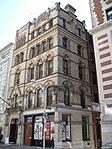Boylston station

Boylston station (also signed as Boylston Street) is a light rail station on the MBTA Green Line in downtown Boston, Massachusetts, located on the southeast corner of Boston Common at the intersection of Boylston Street and Tremont Street. A southbound street-level stop for the SL5 route of the bus rapid transit Silver Line is outside fare control. The station has two island platforms; each has one disused track, making them effectively side platforms. Boylston is not accessible for Green Line trains. Boylston station was opened in 1897 as part of the original segment of the Tremont Street subway. Originally used by streetcars, from 1901 to 1908 it also served Main Line Elevated trains. Unlike other Green Line stations, Boylston has been little modified, and retains much of its original appearance. Two of the original four headhouses have been removed, however, and a sub-passage connecting the platforms has been sealed. Construction of a proposed underground Silver Line station was proposed in the 1990s; that phase of the project was cancelled in 2010.
Excerpt from the Wikipedia article Boylston station (License: CC BY-SA 3.0, Authors, Images).Boylston station
Boylston Street, Boston Beacon Hill
Geographical coordinates (GPS) Address Nearby Places Show on map
Geographical coordinates (GPS)
| Latitude | Longitude |
|---|---|
| N 42.3525 ° | E -71.064722 ° |
Address
Boylston Street 75
02116 Boston, Beacon Hill
Massachusetts, United States
Open on Google Maps










